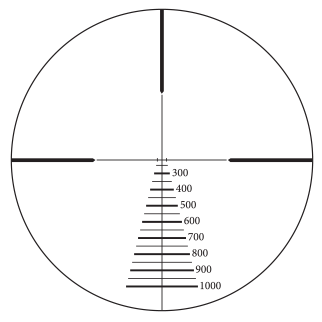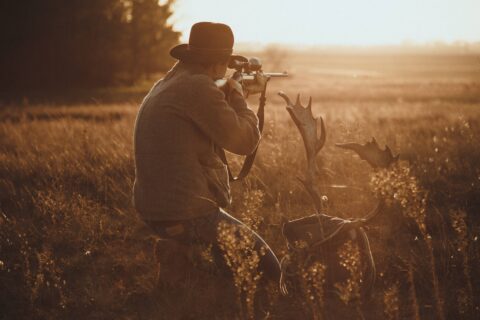Turret style adjustments are very popular with some shooters and can be calibrated to do some very accurate trajectory compensation.
However, we don’t make them for a couple of reasons:
- For one thing Adjustable turret scopes are simply slower to use than utilizing an
etched reticle, and that’s a fact no one can dispute. It is rare to have any extra time to waste when the shot of a lifetime presents itself! - Additionally, while hunting: your gun is often in and out of a scabbard. Do you know if your turrets have moved when the opportunity for a quick shot presents itself? That’s a chance not worth taking when your trophy of a lifetime is at stake
- Often, the game you are hunting is seen in low light situations. Can you trust that as daylight is fading you will be able to read the turrets to make an adjustment?
We allow customers to specify the altitude, temperature and humidity the reticle is etched for, and whether you use our ballistic reticle or a scope with turrets to make adjustments for trajectory, its always advised to take note of changing conditions. You need to decide if you will make an aiming adjustment based on current conditions (whether you use turrets, or a ballistic reticle).
Most ammunition is affected somewhat by temperature, and you won’t know how much yours is affected unless you test it.
You should not make generalized assumptions based upon the results of others, or from one load to another.
Contrary to the fear mongering that has been preached by some people, these factors
(altitude/temperature/humidity) often play a less important role than you may think as far as hunting situations go.
For the purposes of illustration however I will show an example below where we have a load with a hypothetical muzzle velocity difference of 1.5 FPS per degree F in temperature change (with lower temperatures equating to lower velocity / higher temperatures corresponding to a faster velocity)
EXAMPLE
With the following setup:
- Quigley-Ford Scope reticle custom etched for 5,000 ft altitude with a temp of 50 degree F and 50% humidity.
- Using the popular 26 Nosler 142 gr ABLR @3300 fps
- Scope zeroed at 200 yards on centre reticle.
That means:
- The 500 yard reticle is etched to correct for an additional -27.3″ of drop
- The 800 yard reticle is etched to allow for an additional -99.8″ of drop
- The 1000 yard reticle is etched for an additional -180.6″ of drop.
Now if the shooter drops to sea level and the temperature rises to 80 degrees F what happens to the velocity and corresponding trajectory?
- Temp change +30 degrees F so 30 x 1.5 fps is an increase in muzzle velocity of 45 FPS to 3345 fps from 3300.
- Maintaining a 200 yard zero the corresponding drop
- 500 yards is -27.3″ compared to the etched reticle at -27.3″ (no difference at all)
- 800 yard drop would be -101 .8” compared to the etched reticle at -99.8″ (a difference of 2.0″ or ¼ MOA)
- 1000 yards drop would be -186.5” compared to the etched reticle at -180.6″ (a difference of 5.9″ or 6/10 MOA)
I probably don’t need to point out that when you are in field conditions hunting (without the benefit of a bench rest , or even a bipod) that attempting to make a scope adjustment to correct for 1/10 or even 1/2 MOA) is a ridiculous waste of time, when nobody on earth I’ve met can even shoot a group that tight under those conditions, or even if they could, what difference would it make to your hunting success?
Imagine a bull elk standing at 800 yards. If you aim for centre of his lungs and the bullet strikes 2″ from where you thought you aimed, he’s still going to die!
No need to take extra time to make an adjustment when the potential adjustment has far less effect on trajectory than a shooters own shooting ability or the gun/load capability to execute. All loads vary though, and it’s important to note actual differences so you understand them prior to going into different conditions.
In the real world animals don’t stand around long waiting while extra decisions or adjustments are made.
High Altitude Differences
If we travel up to 10,000 feet altitude and temp drops to 32 degrees F:
- Utilizing the same 200 yard zero and corresponding loss of velocity at the lower temp will give us 3275 FPS.
- 500 yard drop is -28.8″ compared to etched reticle -27.3″ or a difference of 1/2 inch (1/10 MOA)
- 800 yards drop is -96.4″ compared to etched reticle -99.8″ or a difference of 2.4″ (1/4 MOA)
- 1000 yard drop is ~172.3”compared to etched reticle -180.6″: or a difference of 8.3″ (still less than 1 MOA)
In practical terms you should always understand what the different conditions will do to bullet flight and make sighting adjustments when necessary.
Practice shooting in field conditions and understand your own capabilities, and don’t try any shots you don’t feel comfortable making.
Most misses at higher or lower altitudes have nothing to do with the actual effect of the different altitude or temperature on the bullet trajectory. Aiming errors are to blame.
One major cause of misses is not shooting to the true horizontal distance to actual target.
That means the shooter is not using a laser rangefinder that provides that correct distance to target.
Most rangefinders in use only provide line of sight distance to target, (which always provide a distance farther than the actual horizontal distance to target: when the target is above OR below the shooter)
These mistakes happen a lot when at a higher altitude,
Imagine you are hunting at 8,000 feet altitude and your (line of sight) rangefinder tells you an elk is 1000 yards away. However the elk is up the side of a steep mountain above you, and had you used a rangefinder with angle compensation to determine his true relative horizontal distance from you, you may find the elk was only 900 (horizontal) yards away.
Gravity only affects bullet drop over the horizontal distance to the target.
The difference in trajectory between 1000yards (-172.3″) and 900 yards (-136.5″) = 35.8 inches
So even if you were rock solid, the distance to target ranging error would cause almost 3 feet of your miss while the etched reticle may have had a potential error of only 1/10 that much. (using the conditions we mentioned).
So range your target… and range it again… and again… if necessary to be certain of the true horizontal distance before worrying about aiming the gun.
Nothing will substitute for effective shooting practice. Common sense says you should replicate your potential hunting situations. You should try shooting from a bipod (if you use one) and/or shooting sticks, off the top of a backpack, off the side of a tree trunk or fencepost and even offhand and accept the results at how poorly you do (in less than ideal conditions), especially if you are on foot and breathing hard.
You will quickly come to realize that to be truly effective and ethical shooting at animals (especially beyond 500 yards), you need to find a way to get rock solid. Anything less than rock solid is a recipe for failure. And if you are shooting off anything less solid than you expect to have with a bipod, then attempting to make sighting adjustments of 1 MOA or less, is pretty much a waste of time.
lf you aren’t stable enough to be sure where the shot is going, don’t shoot!




